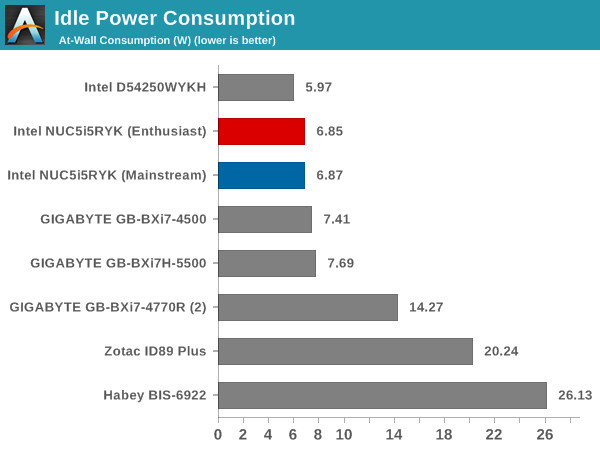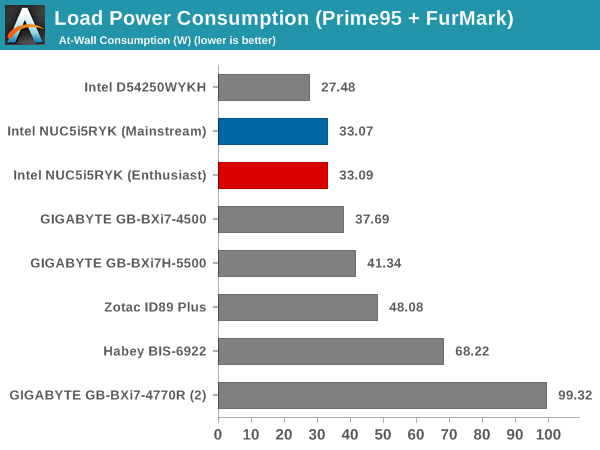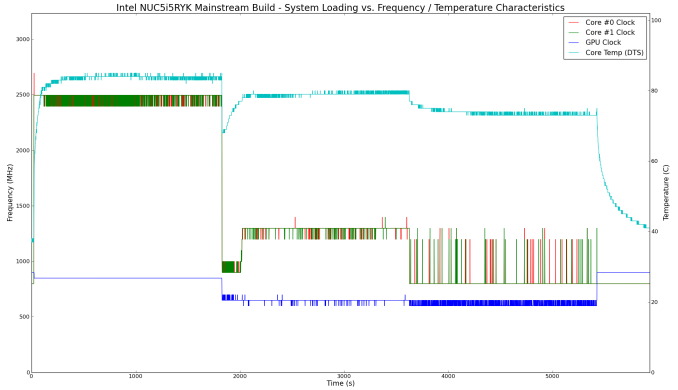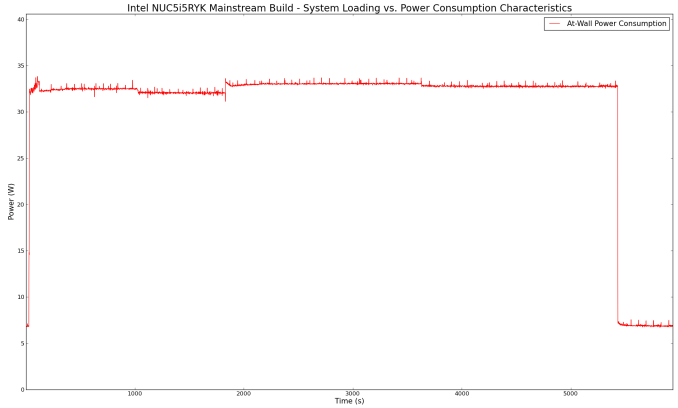Intel NUC5i5RYK Review: A Broadwell-U UCFF PC for Enthusiasts
by Ganesh T S on February 20, 2015 8:00 AM ESTPower Consumption and Thermal Performance
The power consumption at the wall was measured with a 1080p display being driven through the HDMI port. In the graphs below, we compare the idle and load power of the Intel NUC5i5RYK (Enthusiast) with other low power PCs evaluated before. For load power consumption, we ran Furmark 1.12.0 and Prime95 v27.9 together. The numbers are not beyond the realm of reason for the combination of hardware components in the machine.


By default, the BIOS puts the unit in the maximum power consumption / performance mode. The above numbers are with those default settings. It is possible for the end-user to drive down the numbers further with tweaks in the BIOS (at the cost of performance)
In terms of thermal design, the NUC5i5RYK is no different from the Haswell NUC. There are ventilation slots on the side and a small fan directly beneath the lid helps draw in air over the heatsink that is placed behind the slots. On the other side, the lid has a thermal protection strip adhered to it such that it gets placed directly over the M.2 SSD. This ensures proper cooling for the storage media (an issue that one of the previous generation NUCs faced). In order to evaluate the thermal performance, we started with the system at idle, followed by 30 minutes of pure CPU loading. This was followed by another 30 minutes of both CPU and GPU being loaded simultaneously. After this, the CPU load was removed, allowing the GPU to be loaded alone for another 30 minutes.
In the pure CPU loading scenario, the cpre frequencies stay well above the suggested base value of 1.6 GHz, thanks to the BIOS setting controlling the maximum allowed sustained power consumption. The turbo burst frequency of 2.7 GHz is observed only very briefly, and the cores settle down to between 2.4 and 2.5 GHz. We see the temperature stabilizing slightly above 80 C (despite the junction temperature being 105 C). On the other hand, when the CPU and GPU are both loaded, the frequencies drop down to around 1.3 GHz for the cores. The GPU is advertised to run at a base clock of 300 MHz, with a turbo mode of 950 MHz. The actual frequency stays above 700 MHz comfortably throughout our stress test. In the absence of any CPU load, the cores drop down to 800 MHz. The temperatures are also below 80 C throughout the time that the GPU is loaded up. The behavior of the clocks is similar to what we observed for the GIGABYTE Broadwell BRIX s.
The above graph presents the power consumption at the wall during the above thermal stress run. This shows that Intel has designed the NUC with a certain maximum power budget in mind, and the clocks of the CPU and GPU are adjusted depending on the load to obey that configurable TDP. One interesting aspect is that the GPU clock at idle is always reported to be 900 MHz by various tools. We assume there is some sort of inner clock-gating going on beyond the observation point. Otherwise, it is possible to drive down the idle power consumption even further. The thermal performance of the enthusiast build was along the same lines, with a cap of around 34 W for the maximum power consumption at the wall.
All in all, the thermal solution is very effective. Given that the acoustic side-effects were not irksome (subjectively) and the temperature of the CPU package was well under the junction temperature limits, we wonder if Intel has missed a trick by dialing down the overclocking and not allowing the full performance potential of the system to come through with the default BIOS settings.












83 Comments
View All Comments
cjs150 - Friday, February 20, 2015 - link
I am a confirmed HTPC user, I have 2 in the house. One, more powerful, is used to rip Blu rays down to NAS, (plus play, Netflix/Amazon Prime, Web browsing) the other is used simply to play movies, browising, word processing and "Old" gaming - I am a big fan of Total War, old versions.Total silent operation is a must. I do not care how quiet the fan is, in soft parts of movie playback I can hear it.
The old i3 NUC, in a fanless case, makes for an excellent low power HPTC. A Broadwell U will be as good.
My problem is then I am not sure even that power is necessary for most HTPC use where simply streaming from NAS or similar external disk. For the next HTPC I am looking forward to reviews of Intels Bay Tree on a stick, so small it could be stuck behind my AV receiver
edzieba - Friday, February 20, 2015 - link
Having 'too much' power for an HTPC has two main advantages:1) Interface speed. This is both for actual rendering of the interface bells & whistles, and for populating large directories when browsing.
2) CODEC futureproofing. H.265 is on the horizon, and Hi10p H.264 has some very nice benefits in bitrate reduction (or better perceptual quality at the same bitrate), but low power hardware that relies on fixed-function decoder blocks will be left high and dry. Even if they DO have a FFB for a desired CODEC, it may not be sufficient to playback all files (e.g. the number of Level 4.0 h.264 decoders that can't handle full-bitrate Blu Ray streams).
Kutark - Tuesday, February 24, 2015 - link
I'm not sure you realize how little processing power is actually used for rendering. Even now on an old dual core pentium my htpc barely hits 10% utilization on one core while watching h.264 stuff at 1080p. My second htpc which has a ~$55 amd 5xxx series card does most of it via the video card, which also is nowhere even close to being taxed.This setup is WWWAAAYYYY past the needs of any kind of streaming/media/htpc. At these price ranges you can actually build a pretty decent desktop with a dedicated graphics card. Yes, it won't be this small, but you will actually have real graphics performance (i.e. a gtx 960 or r9 280, etc).
yankeeDDL - Friday, February 20, 2015 - link
Wouldn't you consider an AMD-based system a better option for an HTPC? Asking as I am considering one.I recently bought an AMD-based laptop and I am extremely pleased with it as I find it much more effective for casual gaming and, frankly, the CPU performance gap with Intel is "irrelevant" for HTPC use (at least the one I have in mind).
cjs150 - Friday, February 20, 2015 - link
YankeeDDL: Short answer is yes, AMD laptop in many cases is a much better HTPC (unless it has a fan!)But will it look good with the rest of your AV kit? My main HTPC is in a HDPLEX 3 case, which looks great (but pricey), my second HTPC is an i3 NUC in a Tranquil fanless case - again fits right into the AV style.
I guess it depends on what you want. Edzieba is clearly much more of a power user of an HTPC than I am. That does make him right and me wrong (or vice versa), just different. But I have yet to find any user of an HTPC who, with all else being equal, would want to have fans in the HTPC if it could run fanless
Flunk - Friday, February 20, 2015 - link
So you're saying an AMD laptop isn't a better HTPC then? Qualifying it with "unless it has a fan" kinda negates the possibility entirely.
BlueBlazer - Saturday, February 21, 2015 - link
Fans have one big problem, dust accumulation and can lead to clogging (in the cooling vents) which can cause overheating.owan - Friday, February 20, 2015 - link
Its not about being a power user... he's talking about why more cpu punch can be a good thing. If you don't have a fixed function decode block for a new codec and your CPU is too crappy to do it in software, then you need to buy a new CPU and mobo. If bay trail on a stick can't do h.265 you're screwed if you try to play h.265 content, but a broadwell NUC might be able to do it in software (assuming it can't decode in hardware... which it may)BlueBlazer - Saturday, February 21, 2015 - link
Agree, I ran into that problem years ago especially with Hi10p (10-bit H.264) which requires software decoding. Those low power slow CPUs (like AMD E-350 and Atom 330) just would not be able to decode it smoothly. Broadwell already has H.265 as well as 10-bit H.265 and VP9 support in its latest drivers: http://techreport.com/news/27677/new-intel-igp-dri...rmullns08 - Friday, February 20, 2015 - link
cjs150: Interesting that you bring up the HDPLEX 3 case. I currently use a D54250WYKH, but have one major complaint with it being the power supply. I don't use mine as much for HTPC, but do use it for an audio setup (Schiit Modi2 Uber/Magni2 Uber and JBL LRS305), and the power supply is so noisy. I've found that the PSU leaks noise on the negative side, into the chassis which is not properly isolated or grounded. Connecting the DAC results in noise shooting through the system even before the USB cable makes actual contact with the NUC. I've tried different surge protectors, relocating devices onto different outlets to no avail. The other day I actually ordered the HDPLEX linear power supply to hopefully resolve the issue once and for all.